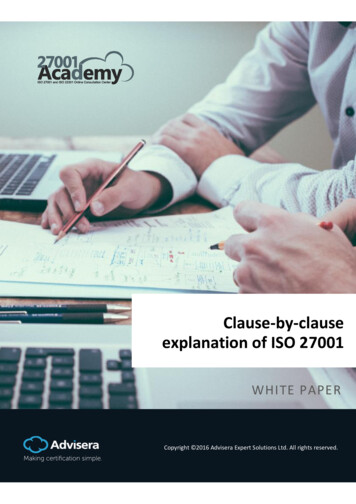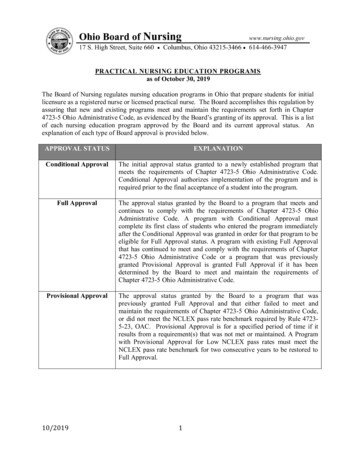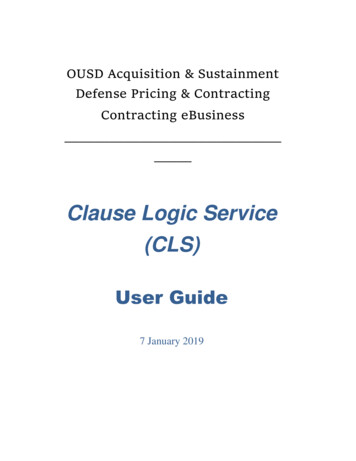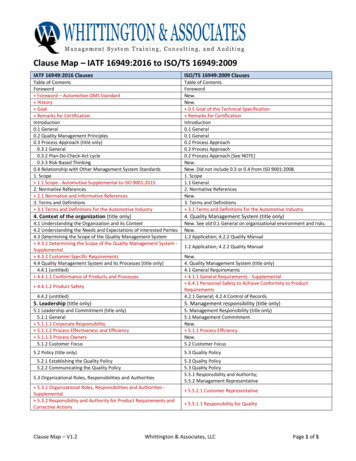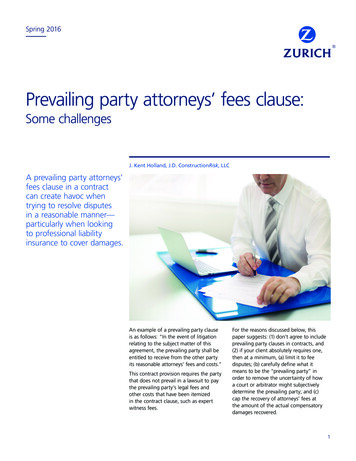
Transcription
Clause-by-clause explanationof ISO 9001:2015WHITE PAPERCopyright 2016 Advisera Expert Solutions Ltd. All rights reserved.Copyright 2016 Advisera Expert Solutions Ltd. All rights reserved.1
Table of ContentsExecutive Summary . 30. Introduction . 31. Process approach . 42. Plan-Do-Check-Act cycle . 53. Terms and definitions . 64. Context of the organization . 75. Leadership . 96. Planning . 107. Support . 118. Operation . 139. Performance evaluation . 1710. Improvements . 19Conclusion . 20Sample of documentation templates . 20References . 20Copyright 2016 Advisera Expert Solutions Ltd. All rights reserved.2
Executive SummaryStriving toward quality and customer satisfaction is the mission of every modern company. ISO 9001provides a framework on how to achieve this, and the first step in the implementation is to reallyunderstand what the standard requires. This white paper is designed to help top management andemployees in organizations that decided to establish and maintain an ISO 9001:2015-based QualityManagement System and clear up any misconceptions regarding the standard requirements.In this document you will find each clause of ISO 9001 explained in plain English in order to facilitateunderstanding of the standard, in the same order and number of the clauses as ISO 9001:2015, and inaddition, you’ll see links to additional learning materials.0. IntroductionManagement systems are often seen as a difficult administrative burden that has marginal contributionto a business. This could be because some people think that ISO 9001 separates them from the way theydo their “business” and limits their management system to simple checklists and work instructions. Bysticking to these beliefs, organizations are missing significant chances to improve their business.How can this standard be used to help daily operations of a company?In this white paper you’ll find the explanation of each clause of the ISO 9001:2015 standard in plainEnglish, so that you’ll be able to use those requirements to improve your processes. You’ll notice thatthe numbers of the subtitles are the same as the clauses in the standard.Please note: this white paper is not a replacement for the ISO 9001:2015 standard – you can get thestandard from the http://www.iso.org website.Copyright 2016 Advisera Expert Solutions Ltd. All rights reserved.3
1. Process approachThe process approach is the key to an effective Quality Management System. It basically means thatevery operation of the company must be observed as a process, meaning you should identify all inputs,necessary resources, documents, activities, and outputs from each operation. Once you set up yoursystem based on the processes, you will be able to monitor and measure your processes, theireffectiveness, and efficiency and improve them, which is the reason why it is emphasized at thebeginning of the implementation, before going into any other details regarding the standardrequirements.In simple terms, the process approach represents the concept of observing all operations in thecompany as processes. This includes breaking the company down into its processes, and determiningtheir sequence, interaction, inputs, and outputs; as well as identifying the processes in the company,which processes can start before other processes are finished, resources and information needed tostart the process, and what results we expect from the process.The best way to start implementing the process approach is to create a process map that will include allprocesses in your company and their interconnections. For example, the delivery process cannot bedone before the production and sales process, and the production cannot be done before thepurchasing of raw materials. Once you create this global process map and identify all the processes andtheir interrelations, you can start defining your processes in terms of what are necessary inputs, whatcontrols need to be applied, and what are the outputs of the process. But this will be done throughoutthe implementation; it doesn’t have to be done at once.To find out more about the process mapping, see: How to create an ISO 9001 process flowchart.Copyright 2016 Advisera Expert Solutions Ltd. All rights reserved.4
2. Plan-Do-Check-Act cycleThe core of this standard, and many other management system standards, is the so-called Plan-DoCheck-Act (PDCA) cycle, which says that, in order to have an effective management system. The firststep in the cycle is planning, which includes defining objectives, policies, procedures, and processes,including measuring aimed to show whether the processes are delivering the expected results. The nextstep is the Do phase, which represents the realization of the planned arrangements, applying policiesand procedures, performing processes, and producing records. After the Do phase comes the Checkphase, where the results of the Do phase are analyzed to determine performance and effectiveness ofthe activities and actions that were taken during the Do phase, which includes analyzing, monitoring,and measuring results, audits, and management reviews. As the final stage of the cycle, the Act phase iswhere the organization needs to take actions according to the results of the Act phase in order toachieve continual improvement. The PDCA cycle should be an ongoing cycle that drives the organizationtowards continual improvement.Quality Management SystemOrganizationand p(6)(5)ActNeeds andexpectationsof ucts andservicesImprovement(10)(4)Copyright 2016 Advisera Expert Solutions Ltd. All rights reserved.5
3. Terms and definitionsAll terms and definitions related to ISO 9001:2015 can be found in the standard. Unfortunately, ISO9001:2015 does not provide any definitions for the terms used, and it is very important to get anunderstanding of the terms before the company starts implementing the requirements of the standard.Here are some of the most important terms and definitions.Top management – An individual or group of individuals who coordinate and control an organization atthe highest level. In cases when the scope of the management system covers just part of anorganization, then top management refers to the individuals who direct and control that part of theorganization.Organization – A person or group of people who has their own functions with responsibilities,authorities, and relationships to achieve the objectives.Context of the organization – A combination of internal and external factors that can have an effect onpurpose, objectives, performance, and sustainability of the organization. Internal factors include values,culture, knowledge, and performance of the organization. External factors include legal, technological,competitive, market, cultural, social, and economic environment.Interested party (stakeholder) – A person or organization that is involved in or perceives itself to beaffected by activities and actions taken by the organization. Interested parties can be customers,suppliers, contractors, local community, government, etc.Process – A sequence of activities that use inputs to deliver an intended result. For example, theproduction process has several steps that must be conducted in the appropriate sequence; inputs in thisprocess are raw materials, product specifications, and work instructions, while the outputs are theproduct, quality check report, etc.Procedure – A defined way to execute an activity or a process. Procedures can be documented or not.Quality – Quality is the difference between a customer’s expectations and the customer’s perception ofthe product or service that he received – the higher the difference, the better perceived quality.Nonconformity – The failure to meet a requirement.Risk – Risk is the “effect of uncertainty on objectives,” and an effect is a positive or negative deviationfrom what is expected. For example, the company plans to deliver its products to the customers, butthere is a risk of product nonconformity due to a poorly controlled production process.Effectiveness – The level of success in achieving or producing a desired result. For example, theproduction process is effective if it is able to produce the products.Copyright 2016 Advisera Expert Solutions Ltd. All rights reserved.6
Documented information – Information required to be controlled and maintained by an organization,and the medium on which it is contained. For example, the documented policies, procedures, workinstructions, and records represent documented information.4. Context of the organization4.1 Understanding organization and its contextThis clause brings new requirements compared to the 2008 version of the standard, and requires theorganization to determine all internal and external issues that may be relevant to the achievement ofthe objectives of the QMS itself. This includes all elements that are, and may be capable of, affectingthese objectives and outcomes in the future.Tip: For more information, see: How to identify the context of the organization in ISO 9001:2015.4.2 Understanding needs and expectations of interestedpartiesDue to the effect that interested parties may have on the organization in terms of quality of productsand services, customer satisfaction, and statutory and regulatory requirements, the standard requiresthe organization to determine interested parties relevant to the QMS and their needs and expectations.Tip: For more information about interested parties, see: How to determine interested parties and theirrequirements according to ISO 9001:2015.4.3. Determining the scope of Quality Management SystemDetermining the scope of the QMS is one of the main milestones in the implementation. The scopemust be examined and defined considering the internal and external issues, interested parties and theirneeds and expectations, as well as legal and regulatory compliance obligations.Additional required considerations for the QMS scope are products, services, and organizational size,nature and complexity. The scope and justified exclusions must be kept as documented information.Copyright 2016 Advisera Expert Solutions Ltd. All rights reserved.7
Tip: For more information about the scope, see: How to define the scope of the QMS according to ISO9001:2015.4.4. Quality Management System and its processesThe organization needs to establish, implement, maintain, and continually improve its QMS, includingthe processes needed and their interactions, in accordance with the requirements of the standard.This is where the process approach comes into action. The organization will need to determine inputsand outputs of the processes, sequence and interaction of the processes, resources needed, andresponsibilities, and ensure the effectiveness of the processes.Also, the organization will have to maintain necessary documented information to support theoperation of the processes and keep records to evidence that the processes were carried out asplanned.Copyright 2016 Advisera Expert Solutions Ltd. All rights reserved.8
5. Leadership5.1 Leadership and commitmentQMS implementation is your strategic decision that demonstrates your commitment to developmentand application of the QMS and continual improvement of its effectiveness. This commitment must bedemonstrated through informing the organization about the importance of fulfilling customerrequirements, compliance with legal and other requirements, establishing a Quality Policy andobjectives, conducting management reviews, and providing needed resources.Tip: For more information about leadership, see: How to comply with new leadership requirements inISO 9001:2015.5.2 PolicyThe
ISO 9001 provides a framework on how to achieve this, and the first step in the implementation is to really understand what the standard requires. This white paper is designed to help top management and employees in organizations that decided to establish and maintain an ISO 9001:2015-based QualityFile Size: 701KBPage Count: 21People also search for10 new clauses of ISO 9001: 2015philosophy of iso 9001sample explanation letter for lacking docu types of configuration management auditsclauses and explaination of ISO 9001:2015Examples of Informed ConsentExplore furtherClauses of the new ISO 9001:2015 standard - Qudosqudos-software.comClause-by- clause Interpretation - ISO 9001 Checklistwww.iso-9001-checklist.co.ukISO - ISO 9001:2015 - Quality management systems .www.iso.orgISO 9001:2015 Requirements - Summary of Each Sectionthe9000store.comINTERNATIONAL ISO STANDARD 9001dmsc.moph.go.thRecommended to you based on what's popular Feedback
